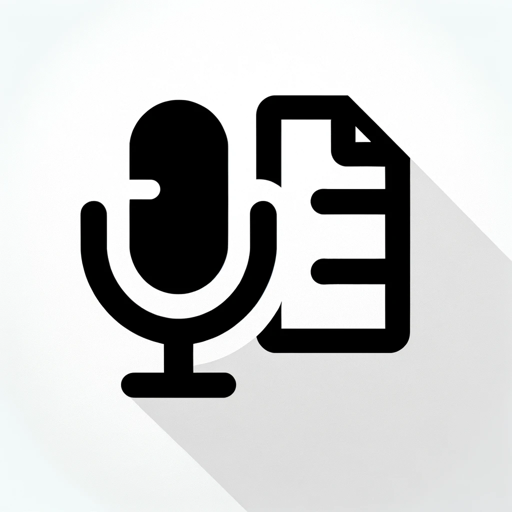Speech to Text Companion-accurate speech transcription
AI-powered transcription made easy
Transcribe this audio for me:
Could you convert my speech into text?
Help me transcribe this meeting.
I need this conversation in written form.
Related Tools
Load More
Speech to Text PRO
Transcribes speech to text with expertise.

Text To Speech
I elevate your text into impactful speech with deep meaning. "People will forget your words, but they will always remember, how those forgotten words made them feel."

Voice to Text
An academic-focused voice-to-text assistant for college students.
Voice-To-Text Notes
Voice-To-Text Note Taking converts spoken words into written text instantly. Ideal for meetings and lectures, it enhances productivity by enabling hands-free, accurate note transcription and easy organization of key information.

Voice Engine Text To Speech
Converts text to speech, max 4096 chars, 6 voices

Voice Decoder
Expert in speech recognition, translating audio to text, and troubleshooting.
20.0 / 5 (200 votes)
Introduction to Speech to Text Companion
Speech to Text Companion is an advanced transcription tool designed to convert spoken language into written text with high accuracy. It is built to handle a variety of accents, dialects, and speech nuances, such as pauses and intonations. The primary purpose of this tool is to provide users with a seamless experience in transforming their spoken words into clear, concise, and correctly formatted text. This is particularly useful in scenarios where quick and precise transcription is necessary, such as in meetings, lectures, or while dictating notes on the go.

Main Functions of Speech to Text Companion
Accurate Transcription
Example
Converting a recorded lecture into text.
Scenario
A student records a lecture and uses Speech to Text Companion to transcribe it, allowing them to have a written record for easier review and study.
Accent and Dialect Recognition
Example
Transcribing a conversation between individuals with different regional accents.
Scenario
During a multi-national conference call, Speech to Text Companion accurately transcribes the conversation despite the participants having varied accents, ensuring clear communication for all attendees.
Handling Speech Nuances
Example
Maintaining the context and meaning in a speech with varied intonations and pauses.
Scenario
A podcaster uses the tool to transcribe an episode, preserving the intended emphasis and pauses to reflect the natural flow of conversation in the written text.
Ideal Users of Speech to Text Companion
Students and Academics
Students and academics can benefit from using Speech to Text Companion to transcribe lectures, interviews, and research notes, enabling efficient study and review processes. The tool ensures that they can focus on listening and engaging during the lecture while having an accurate text version for later reference.
Business Professionals
Business professionals, including executives and managers, can utilize the tool to transcribe meetings, conference calls, and brainstorming sessions. This ensures that all discussions are documented accurately, facilitating better follow-up, action item tracking, and communication within teams.

How to Use Speech to Text Companion
Step 1
Visit aichatonline.org for a free trial without login, also no need for ChatGPT Plus.
Step 2
Ensure you have a stable internet connection and a working microphone for optimal performance.
Step 3
Click on the 'Start Transcribing' button and begin speaking clearly into your microphone.
Step 4
Pause and review the transcription in real-time to make any necessary adjustments or corrections.
Step 5
Save or export the transcribed text in your preferred format once you are satisfied with the accuracy.
Try other advanced and practical GPTs
Speech-to-Text Transcript Recap
AI-powered detailed meeting minutes.

Blackjack Wizard
AI-powered Blackjack mastery tool.

AI Doctor
AI-driven medical insights at your fingertips

Zettelkasten Fleeting Note Creator For Obsidian
AI-Powered Zettelkasten Note Creator for Obsidian

SEOアシスタント
AI-powered SEO optimization for websites

あきんど カナちゃん
Smart, playful insights powered by AI.

Speech to Text
AI-Powered Speech to Text Transcription.

Speech to Text PRO
AI-Powered Speech Recognition for All

統計検定2級_作問&解説
AI-powered statistical exam preparation.

Dirt Bag Airman, an Airforce Writing Assistant
AI-powered Air Force bullet writing assistant

Wine Sommelier
AI-powered wine expertise at your service

Wine Specialist
Your AI-Powered Wine Guide

- Academic Writing
- Content Creation
- Business Meetings
- Podcast Transcription
- Legal Documentation
Frequently Asked Questions about Speech to Text Companion
What types of accents and dialects can Speech to Text Companion recognize?
Speech to Text Companion is designed to recognize a wide range of accents and dialects, ensuring accurate transcription for diverse speech patterns.
Do I need any special equipment to use Speech to Text Companion?
No special equipment is required. However, using a high-quality microphone can enhance transcription accuracy.
Can Speech to Text Companion handle industry-specific jargon?
Yes, it can. The tool is capable of transcribing specialized vocabulary from various fields such as medical, legal, and technical sectors.
Is there a limit to the length of the transcription?
There is no strict limit on transcription length, but it is recommended to take breaks and review the text periodically for the best results.
How secure is my data when using Speech to Text Companion?
Your data is securely processed and stored, adhering to industry-standard privacy and security protocols to ensure confidentiality.